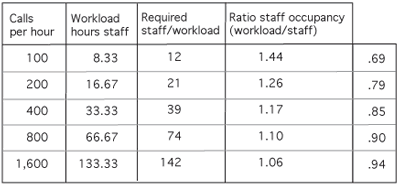One factor that has a major impact on contact center staffing is the size of the center or the agent group. Centers handling larger volumes of calls will naturally be more efficient than smaller ones. This is due to the economies of scale of large groups.
As seen in the example below, doubling the call volume does not require two times the number of staff to meet the same service goal of 80% in 20 seconds. And when call volume increases eight-fold, only about six times the number of staff are needed. As the volume grows, the staff-to-workload ratio gets smaller and smaller.

The reason for these increased efficiencies and the lower staff-to-workload ratio is simply that with a higher volume of calls, there’s a greater likelihood that when an agent is finished with a call, there’s another one coming in right behind it for that person to handle. With a bigger volume, each person has the opportunity to process more calls each hour. Each person spends less time waiting on a call to arrive–in other words, they’re busier or more occupied with call workload.
The measure of how busy agents are is called agent occupancy. It’s the percentage of logged-in time that an agent is actually busy in talk or wrap-up time. It’s calculated by dividing the amount of workload by the staff hours in place. In the table above, with 12 staff handling 8.33 hours of workload, agent occupancy is only 69%. At double the call volume with 21 staff in place, twice the workload is being handled without doubling the workforce, so each person is busier. In this case occupancy has increased to 79%.
As the volume of calls grows, increased efficiencies and economies of scale come into effect, meaning occupancy goes higher and higher. And while we want our staff to be productive and busy, asking staff to stay occupied at a 94% rate is not realistic. Most contact centers aim for the 85%–90% range, since occupancy rates higher than that lead to all kinds of undesirable call handling behaviors as well as a high turnover rate.
But keep in mind that size plays a role. Just because it’s desirable to be in the 85% range doesn’t mean you can get there! Small centers that wish to deliver an 80/20 service level and place sufficient staff in seats may simply not be able to achieve occupancies above 70% or 80%.
Larger centers have just the opposite problem. Their large group efficiencies may allow them to staff for the same 80/20 service level and have occupancy numbers of more than 95%. In such cases, these centers have to “pad” in extra workforce until the additional staff numbers bring occupancy down to a tolerable level.
Think about two common contact center goals: 1) improve service, and 2) improve occupancy. It’s important to understand the relationship between occupancy and service. Agent occupancy is inversely proportional to service level. To improve service, you add staff, and when more people are handling the same amount of work, everyone is less busy and occupancy is lower. Likewise, to “improve” occupancy, you can reduce the number of staff, meaning each person has more work to do and less idle time, But obviously by decreasing staff, you worsen service. So the two go in opposite directions. You can’t improve both at the same time, or even improve one while holding the other constant.
In staffing your contact center, make sure you’re keeping a close watch on your occupancy levels as you evaluate staffing and service level trade-offs.
Penny Reynolds is a founding partner of The Call Center School, a Nashville, TN-based consulting and education company. She will also be leading two sessions at next month’s National Conference on Operations & Fulfillment (NCOF)–“The Seven Deadly Sins of Contact Center Supervision” and “Best-Kept Secrets for Unlocking the Productivity of Your Contact Center Workforce”—as well as moderating a roundtable discussion on home-based contact center agents. NCOF takes place April 9-12 in Orlando, FL; for details visit www.ncof.com.